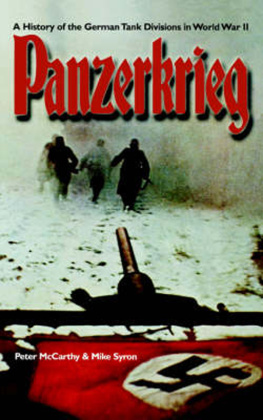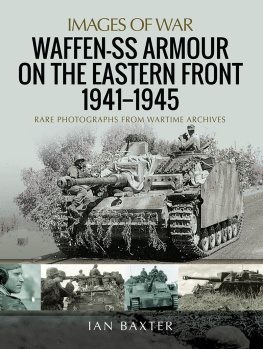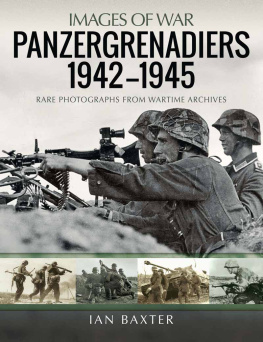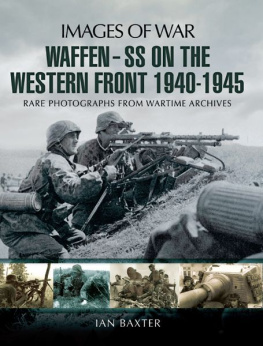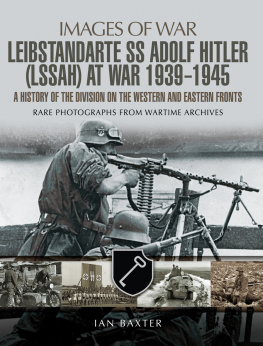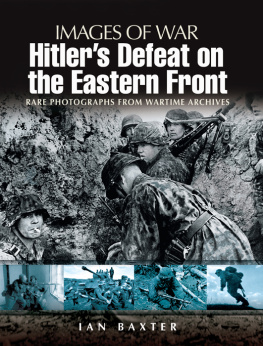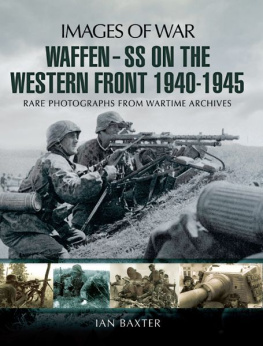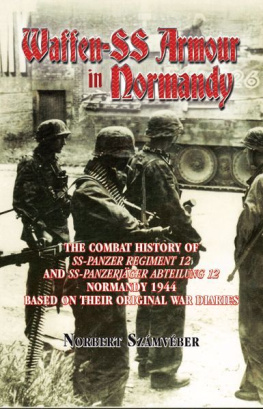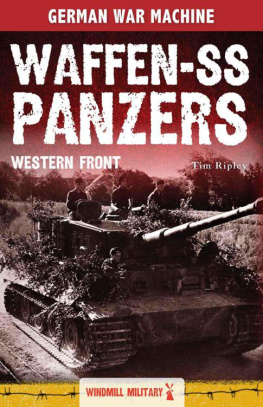
Leibstandarte Panzer IV Ausf F2 in occupied France.
IMAGES OF WAR
ARMOURED WARFARE AND THE WAFFEN SS 19441945
RARE PHOTOGRAPHS FROM WARTIME ARCHIVES
Anthony Tucker-Jones
First published in Great Britain in 2017 by
PEN & SWORD MILITARY
an imprint of
Pen & Sword Books Ltd,
47 Church Street,
Barnsley,
South Yorkshire
S70 2AS
Text copyright Anthony Tucker-Jones, 2017
Photographs copyright as credited, 2017
Every effort has been made to trace the copyright of all the photographs. If there are unintentional omissions, please contact the publisher in writing, who will correct all subsequent editions.
A CIP record for this book is available from the British Library.
ISBN 978 1 47387 794 8
eISBN 978 1 47387 796 2
Mobi ISBN 978 1 47387 795 5
The right of Anthony Tucker-Jones to be identified as Author of this work has been asserted by him in accordance with the Copyright, designs and Patents Act 1988.
All rights reserved. no part of this book may be reproduced or transmitted in any form or by any means, electronic or mechanical including photocopying, recording or by any information storage and retrieval system, without permission from the Publisher in writing.
Pen & Sword Books Ltd incorporates the imprints of Pen & Sword Archaeology, Atlas, Aviation, Battleground, discovery, Family History, History, Maritime, Military, naval, Politics, railways, Select, Social History, Transport, True Crime, Claymore Press, Frontline Books, Leo Cooper, Praetorian Press, remember when, Seaforth Publishing and wharncliffe.
For a complete list of Pen & Sword titles please contact
Pen & Sword Books Limited
47 Church Street, Barnsley, South Yorkshire, S70 2AS, England
E-mail:
Website: www.pen-and-sword.co.uk
Introduction: Hitlers Armoured Bodyguard
T he focus of this book is purely the main armoured operations of the waffen-SS during the latter half of the Second world war. It offers a graphic snapshot of the dramatic tank battles fought by the waffen-SS panzer and panzergrenadier divisions during 19441945 on both the eastern and western Fronts. By this stage these units were at the height of their powers and were involved in major operations in France, russia, the netherlands, Poland and Germany. Most notably the waffen-SSs panzers prolonged the war by staving off defeat, briefly stabilising both the eastern and western Fronts at highly critical points in the fighting.
It is worth highlighting that reichsfhrer-SS Heinrich Himmlers Schutz-Staffel (SS) had a huge variety of units with differing functions. The front-line combat troops of the waffen-SS (Armed SS), with their grey uniforms, should not be confused with the men of the Allgemeine-SS (General SS), with their distinctive ceremonial black uniforms, who were the general service militia of the nazi Party. The latter over the years came to epitomise the SS but they were a separate entity from the waffen-SS.
Similarly, the Sicherheitsdienst (Sd Security Service) security police wore grey, while the Gestapo secret police worked in plain clothes. In addition, the SS-Totenkopfverbnde (deaths Head Units) responsible for running the concentration camps in Poland and russia also dressed in field-grey uniforms. The latter oversaw Hitlers Final Solution and the wholesale murder of europes Jewish population. Then there was a vast range of other police and security units raised within occupied europe and controlled by the SS.
Over the years the waffen-SS has been elevated to a largely undeserved elite status by a series of military historians. The result is that its units are often mentioned in the same breath as Spartan hoplites, Persian immortals, roman Praetorian Guard, Vikings, Japanese Samurai, delta Force and the SAS, to name but a few. This reputation is mainly derived from the performance of a handful of tough SS panzer divisions that fought on the eastern and western Fronts with, it has to be said, some distinction.
In fact, many of these divisions consisted of little more than boy soldiers recruited from the Hitlerjugend (Hitler Youth) and the reich Labour Service. while some of the early waffen-SS field units proved consistently reliable, this was as a result of a selection and training process deeply rooted in nazi ideology. This politically motivated fanaticism spilled over into their conduct and regularly resulted in wholly unjustifiable war crimes and atrocities.
The waffen-SS grew from the SS-Verfgungstruppen (SS-VT SS dispositional Troops), the military wing of the Schutz-Staffel the Fhrers personal protection squad. Ironically, after his experiences with the powerful pre-war Sturmabteilung (SA: Storm detachment) of the national Socialist German workers Party (nSdAP or nazi Party), Adolf Hitler was not in favour of large private armies. However, the SS was used to decapitate and take control of the SA, ensuring it posed no threat to Hitlers steady rise to power.
The deployment of SS units during the invasions of Poland and the west were simply designed to allow reichsfhrer-SS Himmlers power base to share in Germanys military triumphs. Himmler had assumed control of the SS in 1929 and immediately set about empire building. The premier formation, Leibstandarte-SS Adolf Hitler , evolved from Hitlers pre-war bodyguard commanded by Sepp dietrich. Likewise Das Reich , formerly the SS-VT division, evolved from the remainder of the pre-war armed SS. From these units grew Himmlers autonomous army of over half a million men, fully equipped with tanks and artillery.
In total, the waffen-SS, a very distinct and independent entity from the regular German Army, raised (on paper at least) a total of thirty-eight divisions during the Second world war. of these, seven were panzer divisions and another eight were panzergrenadier divisions. The most famous or perhaps infamous armoured formations were the 1st SS Leibstandarte-SS Adolf Hitler , the 2nd SS Das Reich and the 12th SS Hitlerjugend . The 5th SS Wiking , the 9th Hohenstaufen and the 10th SS Frundsberg also gained reputations as fierce and brutal fighters. The least well known was the 3rd SS Totenkopf , which was initially raised from concentration camp guards.
The panzergrenadier divisions comprised the 4th SS Polizei , the 16th SS Reichsfhrer-SS , which gained an unsavoury reputation in Italy, the 11th SS Nordland , the 17th SS Gtz von Berlichingen which fought in normandy, the 18th SS Horst Wessel , the 23rd SS Nederland , the 28th SS Wallonien and the 38th SS Nibelungen . The latter was recruited from teenage SS cadets in March 1945 and never even reached regimental size. Most of these units included single panzer and assault gun battalions.
The emergence of Himmlers panzer divisions was not just a political vanity project; there were sound strategic reasons for upgrading them from the early motorised units. The expansion of German strength in 1943 had clearly accelerated after rommels defeat at el Alamein in november 1942, the Allied landings in French north Africa that same month and by the destruction in early 1943 of the German forces trapped at Stalingrad. Liebstandarte-SS Adolf Hitler , Das Reich and Totenkopf were transformed into panzergrenadier units for the spring 1943 counter-offensive in the Soviet Union, each with an integral tank battalion. This increase in combat power had been authorised in early 1942 but was not implemented until the second half of the year. notably, the Wiking division was also allocated a tank battalion but stayed in the line instead of being withdrawn to France to re-equip.


